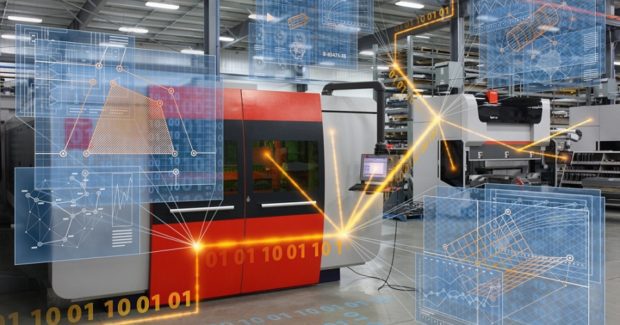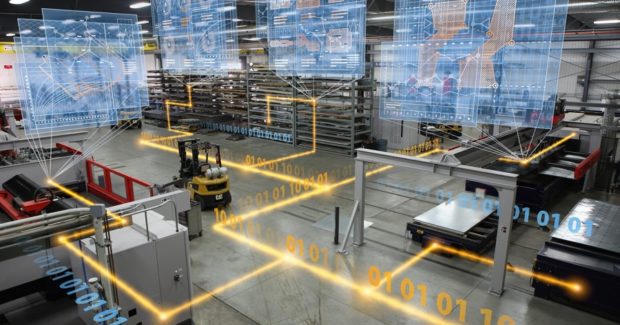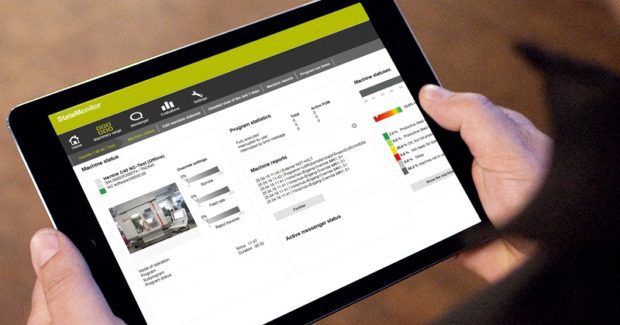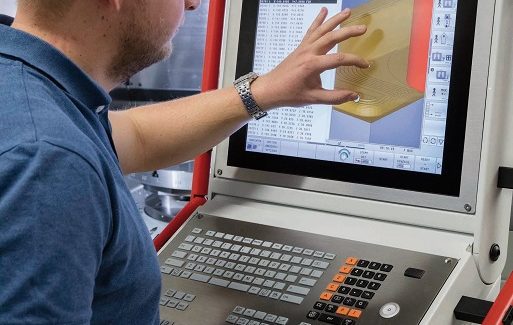Can We Talk? Conversations Between Machines Get Deep (Part One)
Across the emerging Smart Factory, connected systems are networking production processes from design to final delivery. Conversational programming makes it quick and easy for operators to generate programs at the machine, while other connected systems exchange and use information about tool management, batch processing/scheduling, machine monitoring, quality assurance and more.
Posted: June 10, 2019
Communication is the successful sharing, exchange and understanding of information that bridges gaps or voids to connect one entity with others. It is the cornerstone of the digital thread in automation that connects processes from part design to after-sales support so that manufacturers can better understand their customers for competitive advantage. On the shop floor, an integral part of this connected manufacturing environment is driven by CNC controls that communicate deep process data extending from cutting tool performance to machine monitoring to ERP systems. As these controls become easier to use, they’re also becoming much more powerful. Being able to load a part file or program into a CNC via a USB port was a good advancement for its time. But now, controls connected to CAD/CAM systems allow the operator to access part files, data and set-up sheets without ever leaving the machine – and do so in a secure environment. “Graphic interfaces, applications and connectivity have expanded CNC control functionality so that operators can make intelligent decisions and take immediate action on the shop floor,” said Peter R. Eelman, the vice president of exhibitions and business development at AMT – The Association for Manufacturing Technology (McLean, VA).
This expanded control functionality extends to other personnel working remotely from the CNC – located in engineering or quality control or management at another facility – who also want to capture, analyze and act on that CNC-related data, which includes machine status, current program running, spindle speed, availability, utilization rate and errors. They can also access non-conventional data sources, include tooling, workholding and discrete machine parts, such as pumps, motors and encoders. “Control manufacturers have placed a greater focus on importing more data into the machine control via MTConnect-enabled devices,” explained Gisbert Ledvon, the TNC business development manager at Heidenhain Corporation (Schaumburg, IL). “They have also developed software applications that graphically present information so that shop owners can make good decisions more easily.” For flexibility, information can remain strictly within a user’s firewalls, can be accessed via the cloud or accessed from both.
Job shops don’t have the luxury of scrapping multiple parts to refine a program. Their first part needs to be a good part, but achieving this goal has become a bigger challenge because product designers have increased part complexity to take advantage of expanding machine capabilities. As parts become more complex, it makes no sense to continue using outdated controls, which means job shops must keep pace with new control technology to keep scrap rates low. For example, machine controls now enable operators to switch the NC program between the desired functions, giving job shops the freedom to decide how and when they want to combine machining methods, an important development that is necessary to keep pace with the expanded functions available from 5-axis mill turns. This engagement of operators is essential for optimizing manufacturing processes, which is why new control capabilities include the ability to import a part file, call up a 3D model, zoom and rotate the display using touch screen controls, select portions of the file to modify and have the controls automatically generate new code.
“If operators discover a missing part feature or need to modify the cutting path to avoid a collision, they can make changes without engineering support,” noted Ledvon. “Operators working on second or third shift tell us how they finished a batch of parts on time or minimized the number of bad parts because of new control capabilities. They also provide immediate feedback to CAD/CAM and quality control systems.” Taking this a step further, other improvements include connecting controls to vision systems that can compare the current image to a reference image and spot any deviation from a perfect setup, such as a missing hole for the next threading application, a broken drill in the part, a part not clamped correctly in a vice or on pallet, a wrong engraved part number on the part or a wrong part on the pallet. “It functions much like the face recognition feature of your iPhone,” noted Ledvon. “If something doesn’t look exactly right, the control will find it.” This ability of the control to quickly and precisely scan data to verify changes and deviations points toward a new, much deeper stage of communication.
Artificial Intelligence: The Next Generation of Communication
Manufacturing generates an unprecedented amount of data, creating an urgent need for shops to augment human analysis with AI that can unlock its value, learn from the historical knowledge embedded in their organizations, and help them remain competitive in the future.
Machine learning and artificial intelligence may ultimately minimize the need for humans to interact with controls in the connected manufacturing world, but for now those developments remain over the horizon as new control technology sweeps through the metal fabrication industry, making processes more accurate and shops of all sizes more productive by eliminating sources of waste. Take a closer look at some of the latest innovations that are shaping the future of manufacturing:
The Ultimate Navigation System for Managing Sheet Metal Production
Manufacturing Execution System software from Bystronic allows shops to record, plan, and evaluate every individual manufacturing step of their sheet metal production process, managing each step according to a defined timeline to realize potential process improvement possibilities.
End-To-End Digitalization for the Machine Tool Business
In both the construction and utilization of machine tools, Siemens is laying the foundation for digital penetration and restructuring of complete value chains that will boost the growth and profitability of both machine builders and users alike in shops of all sizes.
Online Equipment Monitoring Drives Productivity Improvements
The CoroPlus MachiningInsights digital system from Sandvik Coromant collects data directly from a connected machine tool and input from operators, making it possible to visualize machine and tool utilization levels online through a web browser and collaborate to make improvements within the factory.
Create A Community for Sharing Metalworking Automation
Using the HKP Mobile App from Haydon Kerk Pittman, technical information and other resources on linear and rotary solutions can be easily shared among colleagues and teams for automation in metalworking, inspection and material handling applications.
Sensors + Software = End-To-End Internet of Things
The Connected Data Solutions Platform from Banner Engineering allows users to easily and securely transmit and use remote data from cloud-connected devices to monitor shop productivity, predict machine maintenance requirements and make operational decisions on machine performance.
Secure Transfer of Process Data to Mobile Devices
TwinCAT IoT Communicator software and the IoT Communicator App for tablets and smartphones from Beckhoff Automation uses advanced encryption and protocol for easy mobile device integration and high-level communication security.
Automatic Data Analysis Increases Shop Floor Efficiency and Reduces Downtime
ShopFloorConnect 6.0 OEE and Shop Floor Data Collection software from Wintriss Controls gathers production data from every machine in the factory, displays the Key Performance Indicators in real-time and produces detailed analytics, including comprehensive OEE reports in a variety of formats.
Cybersecurity of Communications Between Controls
By passively intercepting and monitoring serial communications on industrial control networks for intrusion detection and asset management, the SerialTap cybersecurity sensor from Cynash helps shops address and solve complex security challenges that affect their legacy control systems.
Automated Monitoring of First Piece Inspection on the Shop Floor
Working in conjunction with eNET Machine Monitoring, the eNET QC Status Dashboard from eNETDNC is locally-hosted software that increases visibility and accountability throughout the quality control operation for the first-piece inspection process.
Driving Towards Seamless Factory Connectivity
Excellerant connects every CNC machine tool controller, no matter the brand, so that shops of all sizes can monitor and manage each machine’s data in real-time and send that data to the company MES and/or ERP systems for more accurate forecasts and dynamic scheduling.
Flexible Tablet Interface for Easy Exchange of Shop Floor Information
For CNC machine tool and non-CNC asset monitoring and data collection, the Flexible Tablet Interface from FactoryWiz uses a live display dashboard to drive behavior and see quantifiable improvement in shop productivity.
5G Adaptive Process Control with Extremely Short Reaction Times
Developed by GF Machining Solutions and their partners, this networked adaptive manufacturing system for real-time process monitoring uses 5G technology to communicate with sensors and machines in under one millisecond and reduce errors in high speed machining of complex aerospace parts.
For more information, don’t miss Part Two of this series. Also, look at other advances in machine controls and also subscribe to F&M.



















